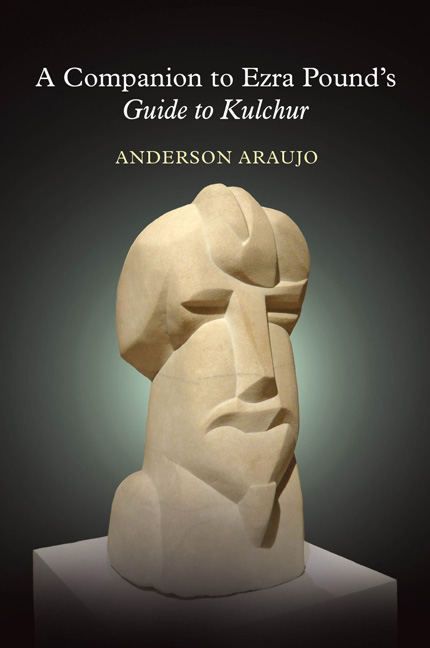Book contents
- Frontmatter
- Contents
- Acknowledgments
- Abbreviations
- Introduction
- Guide to Kulchur
- Part I
- Section I
- 1 Digest Of The Analects
- 2 The New Learning: Part One
- 3 Sparta 776 B.C.
- 4 Totalitarian
- 5 Zweck or the Aim
- Section II
- Part II
- Section III
- Section IV
- Part III
- Section V
- Section VI
- Part IV
- Section VII
- Section VIII
- Section IV
- Part V
- Section X
- Section XI
- Part VI
- Section XII
- Section XIII
- Addenda: 1952
- Notes
- Index
5 - Zweck or the Aim
from Section I
- Frontmatter
- Contents
- Acknowledgments
- Abbreviations
- Introduction
- Guide to Kulchur
- Part I
- Section I
- 1 Digest Of The Analects
- 2 The New Learning: Part One
- 3 Sparta 776 B.C.
- 4 Totalitarian
- 5 Zweck or the Aim
- Section II
- Part II
- Section III
- Section IV
- Part III
- Section V
- Section VI
- Part IV
- Section VII
- Section VIII
- Section IV
- Part V
- Section X
- Section XI
- Part VI
- Section XII
- Section XIII
- Addenda: 1952
- Notes
- Index
Summary
Zweck: (Ger.) “Purpose, aim.”
The ideogramic method: A core component of Pound's poetics. It stems from the quasi-mystical epistemology that he derived from editing Fenollosa's essay, “The Chinese Written Character as a Medium for Poetry” (1913/1920). Confucius, Gourmont, and Swedenborg (cf. notes GK 88, 73) also influenced Pound's method. As Pound suggests, the ideogrammic method is associative and combinatory. The heuristic juxtapositions he outlines here enable him to assemble a mosaic of gists and piths, which he hopes will ultimately coalesce to form a coherent image in the reader's mind. Pound seeks to create a new stereoscopic consciousness capable of shoring up the scattered ruins of the past to build a new civilization. Once gathered, these bits and pieces are deployed as “luminous details.” Kenner has described this technique as “‘patterned integrities’ which [when] transferred out of their context of origin retain their power to enlighten us.” In ABC of Reading (1934), Pound explains that the
Chinese ideogram does not try to be the picture of a sound, or to be a written sign recalling a sound, but it is still the picture of a thing; of a thing in a given position or relation, or of a combination of things. It means the thing or the action or situation, or quality germane to the several things that it pictures […]
[A Chinese person] is to define red. How can he do it in a picture that isn't painted in red paint?
He puts (or his ancestor put) together the abbreviated pictures of
ROSE CHERRY
IRON RUST FLAMINGO
For Pound, a language thus inscribed is inherently poetic. Moreover, he sees his ideogrammic method as carrying on and systematizing Fenollosa's unfinished work, since the sinologist “died before getting round to publishing and proclaiming a ‘method.’” That the ideogram is paramount in Pound's mind as he was writing GK may be gleaned in a letter he wrote to the classicist W. H. D. Rouse on October 30, 1937 (cf. note GK 71).
- Type
- Chapter
- Information
- A Companion to Ezra Pound's Guide to KulcherGuide to Kulcher, pp. 75 - 90Publisher: Liverpool University PressPrint publication year: 2018

